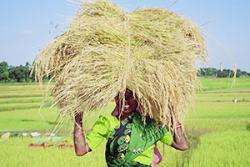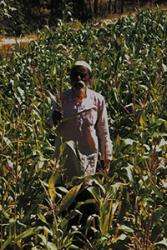Improving the livelihoods of over 5M households in India and Nepal

A pioneering new method of plant breeding is improving the livelihoods of over 5M households in India and Nepal.
The novel approach, selective plant breeding, was originally developed by Prof John Witcombe at Bangor University to meet the identified needs of resource-poor farmers in the more arid regions of Gujarat, India. He works with indigenous farmers and consumers, introducing properties that are desired by farmers into rice and maize varieties and incorporating on-farm varietal testing and farmers' experiences. This method has produced new varieties of rice and maize which are highly adapted to the requirements and preferences of local farmers, which in turn improves their adoption and spread among the farming community.
Participatory varietal selection (PVS) of popular rice variety BG1442 in Nepal and the development of 10 new rice varieties using his innovative client oriented breeding (COB) methods in India and Nepal has led to the new varieties being grown on at least 500,000 ha and providing a 15–40% yield advantage over the varieties grown traditionally.
In India, two 'Ashoka' rice varieties alone (200F and 228) are estimated to provide benefits of £17M annually to the poorest farming households. These varieties are popular for their high yield, grain quality, superior taste and fodder yield. Their early harvest provides food during lean periods and their pest and drought resistance results in low cost and labour requirements.

In real terms, these direct benefits can allow farmers to plant additional crops or devote time to non-agricultural activities, providing extra income and permitting them to send their children to school.
A new maize variety has had a major impact on food production in Western India between 2008-13. GM-6 has delivered 360,000 tonnes of additional food grain during that period, with a total net present value to these farm households of an average of at least £9M per year.
A pioneering new method of plant breeding is improving the livelihoods of over 5M households in India and Nepal.
The novel approach, selective plant breeding, was originally developed by Prof John Witcombe at Bangor University to meet the identified needs of resource-poor farmers in the more arid regions of Gujarat, India. He works with indigenous farmers and consumers, introducing properties that are desired by farmers into rice and maize varieties and incorporating on-farm varietal testing and farmers' experiences. This method has produced new varieties of rice and maize which are highly adapted to the requirements and preferences of local farmers, which in turn improves their adoption and spread among the farming community.
Participatory varietal selection (PVS) of popular rice variety BG1442 in Nepal and the development of 10 new rice varieties using his innovative client oriented breeding (COB) methods in India and Nepal has led to the new varieties being grown on at least 500,000 ha and providing a 15–40% yield advantage over the varieties grown traditionally.
In India, two 'Ashoka' rice varieties alone (200F and 228) are estimated to provide benefits of £17M annually to the poorest farming households. These varieties are popular for their high yield, grain quality, superior taste and fodder yield. Their early harvest provides food during lean periods and their pest and drought resistance results in low cost and labour requirements.
In real terms, these direct benefits can allow farmers to plant additional crops or devote time to non-agricultural activities, providing extra income and permitting them to send their children to school.
A new maize variety has had a major impact on food production in Western India between 2008-13. GM-6 has delivered 360,000 tonnes of additional food grain during that period, with a total net present value to these farm households of an average of at least £9M per year.
Provided by Bangor University


















